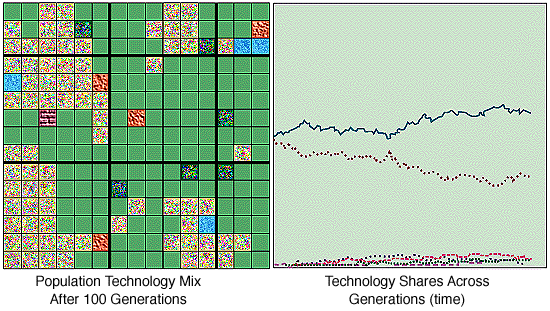Evolutionary Algorithms for Technology Adoption and Diffusion

The emergence of a spatial pattern of technology selection is shown, with the increasing dominance of a single technology. The dominant technology is demonstrated through the solid blocks on the left and the top line on the right.
Question
What can be learned from new individual-based evolutionary algorithms about the adoption and diffusion of new complex technological systems and networks?
Findings
Complex technologies (e.g., new computer systems or vehicle/motor-fuel systems) often involve a network of related or compatible technologies and support infrastructure. The patterns of new technology adoption are influenced by issues of technology compatibility and infrastructural requirements. Evolutionary algorithms are well suited to modeling populations of representative economic agents or individuals. The representative agents make independent technology choices, but consider the compatibility of their choices with the choices of other agents and with the installed base infrastructure.
The above figure shows the emergence of a spatial pattern of technology selection (the grouping of dark and patterned blocks), and the increasing dominance of a single technology (the technology share history lines on the right). Using alternative-fueled vehicles as an example, the approach is used to examine path dependence, the possibility of technology lock-in, and the opportunities for successful new technology introduction through niche dominance.More
Leiby, P. and D. Huff. 1994. Simulation of adaptive learning and simple technology choice using an interactive genetic algorithm. Oak Ridge National Laboratory, Oak Ridge, Tenn. (draft).For more information, contact:
Paul Leiby (leibypn@ornl.gov, 865-574-7720)
